parking brake CADILLAC DEVILLE 1993 7.G Owners Manual
[x] Cancel search | Manufacturer: CADILLAC, Model Year: 1993, Model line: DEVILLE, Model: CADILLAC DEVILLE 1993 7.GPages: 406, PDF Size: 20.78 MB
Page 71 of 406

Downloaded from www.Manualslib.com manuals search engine FEATURES AND CONTROLS
Here you can learn about the many standard and optional features on
your Cadillac, and information on starting, shifting and braking.
Also
explained are the instrument panel and the warning systems that tell you
if everything is working properly -- and what to do if you have a problem.
KEYS
A CAUTION
0.
Leaving young children in a vehicle with the ignition key is
&mgemus for many IT~S~RS. A child or others could be badly
injured or &en killed.
They could operate power windows or other controls or even
make the vehicle move. If they turned the ignition to ‘‘ON’9 and
moved the shifi lever out of 6rP” (Park), that would releasi the
parking brake. Don’t leave the keys in a vehicle with young
children.
I-
-
01
0
-
Ca
Page 92 of 406
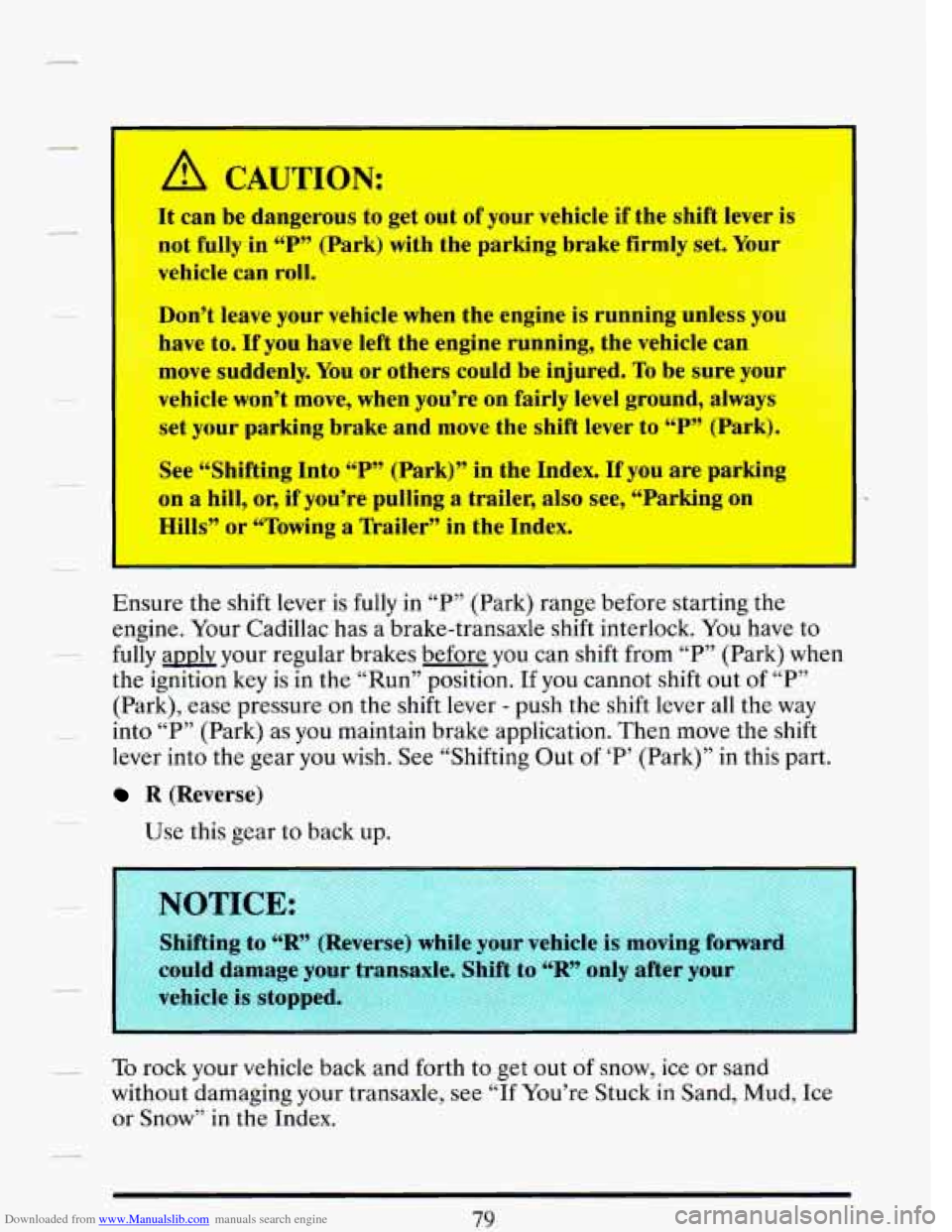
Downloaded from www.Manualslib.com manuals search engine - I
’
A CAUTION:
It can be dangerous to get out of ---ur vehicle if the shift lever is
not fully in
“P” (Park) with the parking brake firmly set. Your
vehicle can roll.
s-4 W$&I
Don’t leave your vehicle when the engine is running unless y
have to. If you have left the engine running, the vehicle can
move suddenly.
You or others could be injured. To be sure yo
vehicle won’t move, when you’re
on fairly level ground, always
set your parking brake and move the shift lever to
“P” (Park).
See “Shifting Into “P” (Park)” in the Index. If you are parking
on
a hill, or, if you’re pulling a trailer, also see, “Parking on
Hills” or “Towing
a nailer” in the Index.
Ensure the shift lever is fully in
“P” (Park) range before starting the
engine. Your Cadillac has a brake-transaxle shift interlock.
You have to
fully amlv your regular brakes before you can shift from “P” (Park) when
the ignition key is in the “Run” position.
If you cannot shift out of “P”
(Park), ease pressure on the shift lever
- push the shift lever all the way
into
“P” (Park) as you maintain brake application. Then move the shift
lever into the gear you wish. See “Shifting Out
of ‘P’ (Park)” in this part.
R (Reverse)
Use this gear to bacK
up.
hifting to “R” (Reverse) while your vehicle is m
ould damage your t
To rock your vehicle back and forth to get out of snow, ice or sand
without damaging your transaxle, see “If You’re Stuck
in Sand, Mud, Ice
or Snow” in the Index.
79
Page 95 of 406
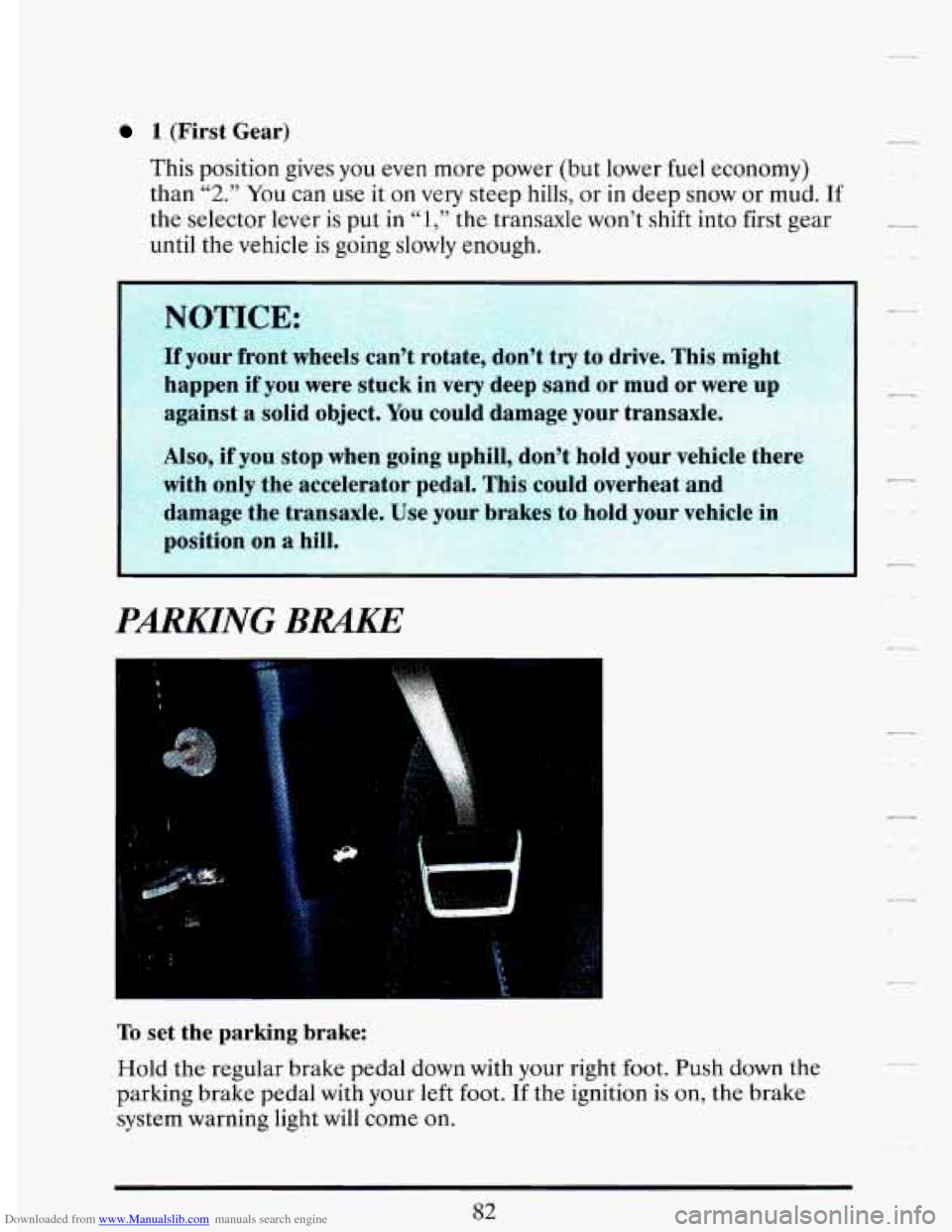
Downloaded from www.Manualslib.com manuals search engine 1 (First Gear)
This position gives
you even more power (but lower fuel economy)
than
“2.” You can use it on very steep hills, or in deep snow or mud. If
the selector lever is put in “1,” the transaxle won’t shift into first gear
until the vehicle
is going slowly enough.
7
..
~ If your front wheels can’t rotate, don’t try to drive. This might
~ happen if you were stuck in very deep sand or mud or were up
against
a solid object. You could damage your transaxlc.
Also, if you stop when going uphill, don’t hold your vehicle the]
j with only the accelerator pedal. This could overheat and
~ damage the transaxle.
position on a hillm
I Jse your brakes to hold your.vehic
.. .. ~ -
--
P-NG BRAKE
To set the parking brake:
Hold the regular brake pedal down with your right foot. Push down the
parking brake pedal with your left
foot. If the ignition is on, the brake
system warning light will come on.
Page 96 of 406
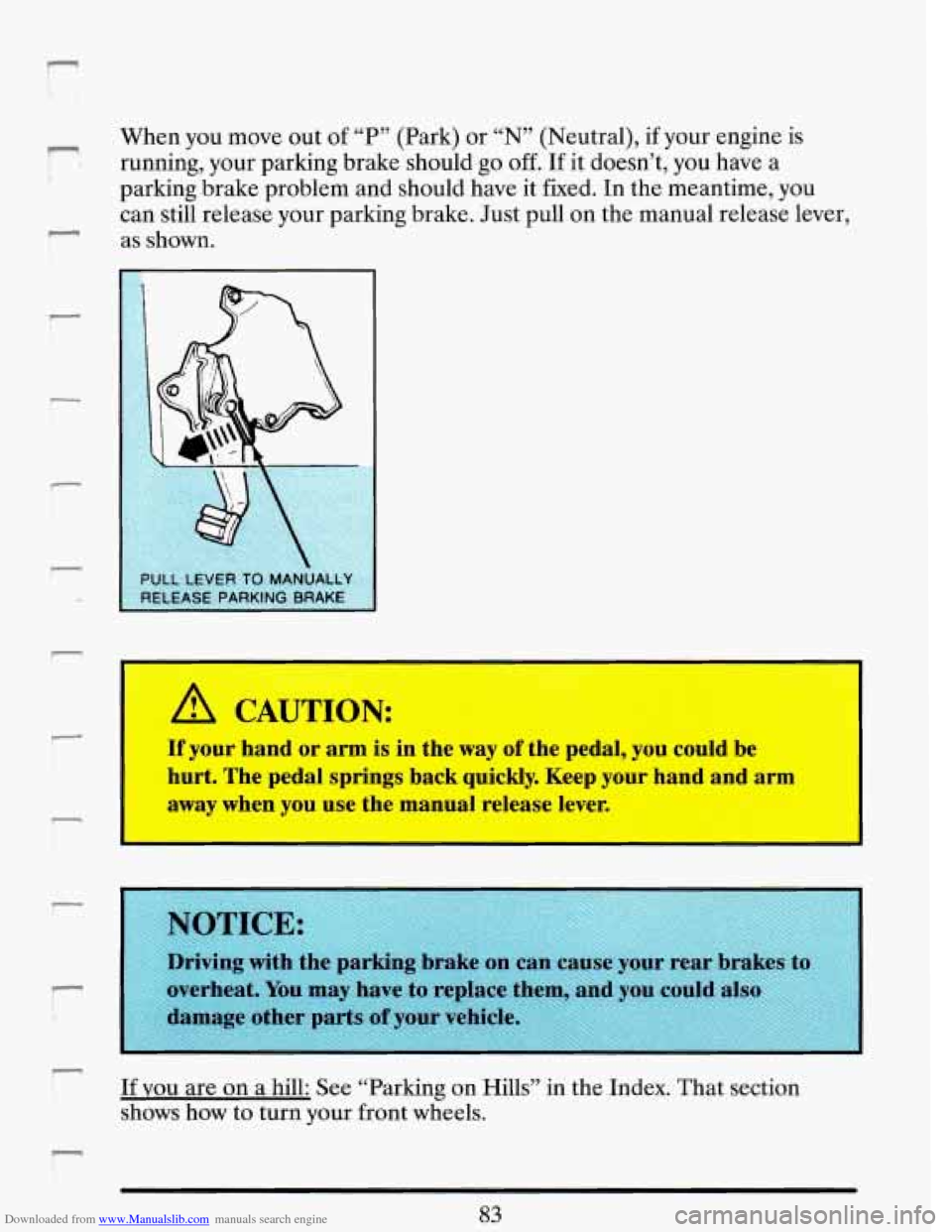
Downloaded from www.Manualslib.com manuals search engine r
r
When you move out of “P” (Park) or “N” (Neutral), if your engine is
running, your parking brake should go
off. If it doesn’t, you have a
parking brake problem and should have it fixed. In the meantime, you
can still release your parking brake. Just pull on the manual release lever,
as shown.
-
A CAUTION:
r If your hand or arm is in the way of the pedal, you could be I
hurt. The pedal springs back quickly. Keep your hand and arm
-- se thr -1anual r -’ - - -e lever. r
r
r
* See “Parking on Hills” in the Index. That section
shows how to turn your front wheels.
Page 97 of 406
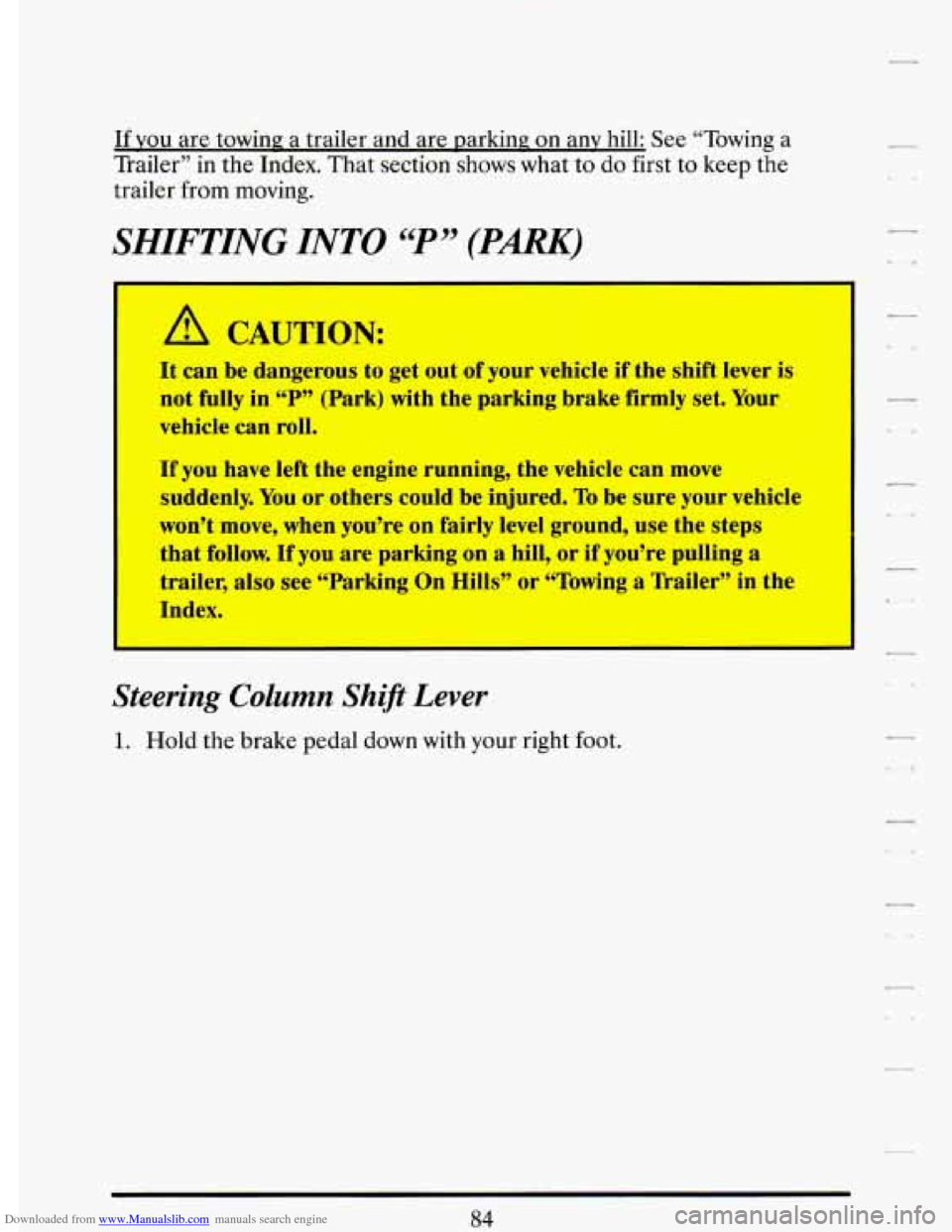
Downloaded from www.Manualslib.com manuals search engine If YOU are towinn a trailer and are parking; on any hill: See “Towing a
Trailer” in the Index. That section
shows what to do first to keep the
trailer from moving.
SHIFTING INTO “P” (PARK)
I A CAUTION:
I It can be dangerous to get out of your vehicle if the shift lever is
not fully in
“P” (Park) with the parking brake firmly set. Your
vehicle can roll.
If you have left the engine running, the vehicle can move
suddenly. You or others could be injured. To be sure your vehicle
won’t move, when you’re on fairly level ground, use the steps
that follow.
If you are parking on a hill, or if you’re pulling a
trailer, also see “Parking On Hills” or “Towing a Trailer” in the
Index.
I
I
Steering Column Shi! Lever
1. Hold the brake pedal down with your right foot.
7
b.
84
Page 98 of 406
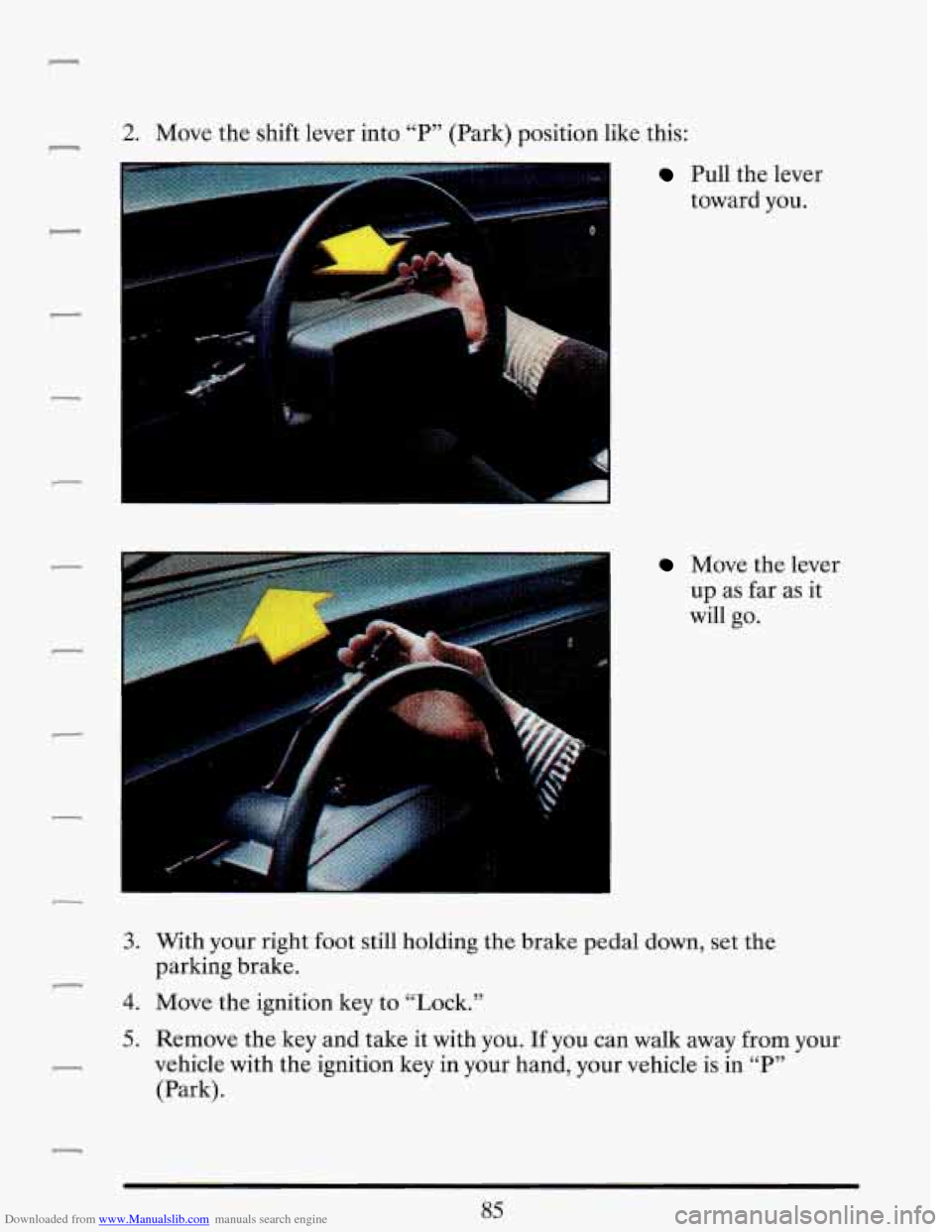
Downloaded from www.Manualslib.com manuals search engine 2. Move the shift lever into “P” (Park) position like this: -
f 1
Pull the lever
toward you.
Move the lever
up as far as it
will go.
3. With your right foot still holding the brake pedal down, set the
4. Move the ignition key to “Lock.”
parking
brake.
-
5. Remove the key and take it with you. If you can walk away from your
vehicle with the ignition key in your hand, your vehicle is in
“P7’
(Park).
85
-
Page 99 of 406
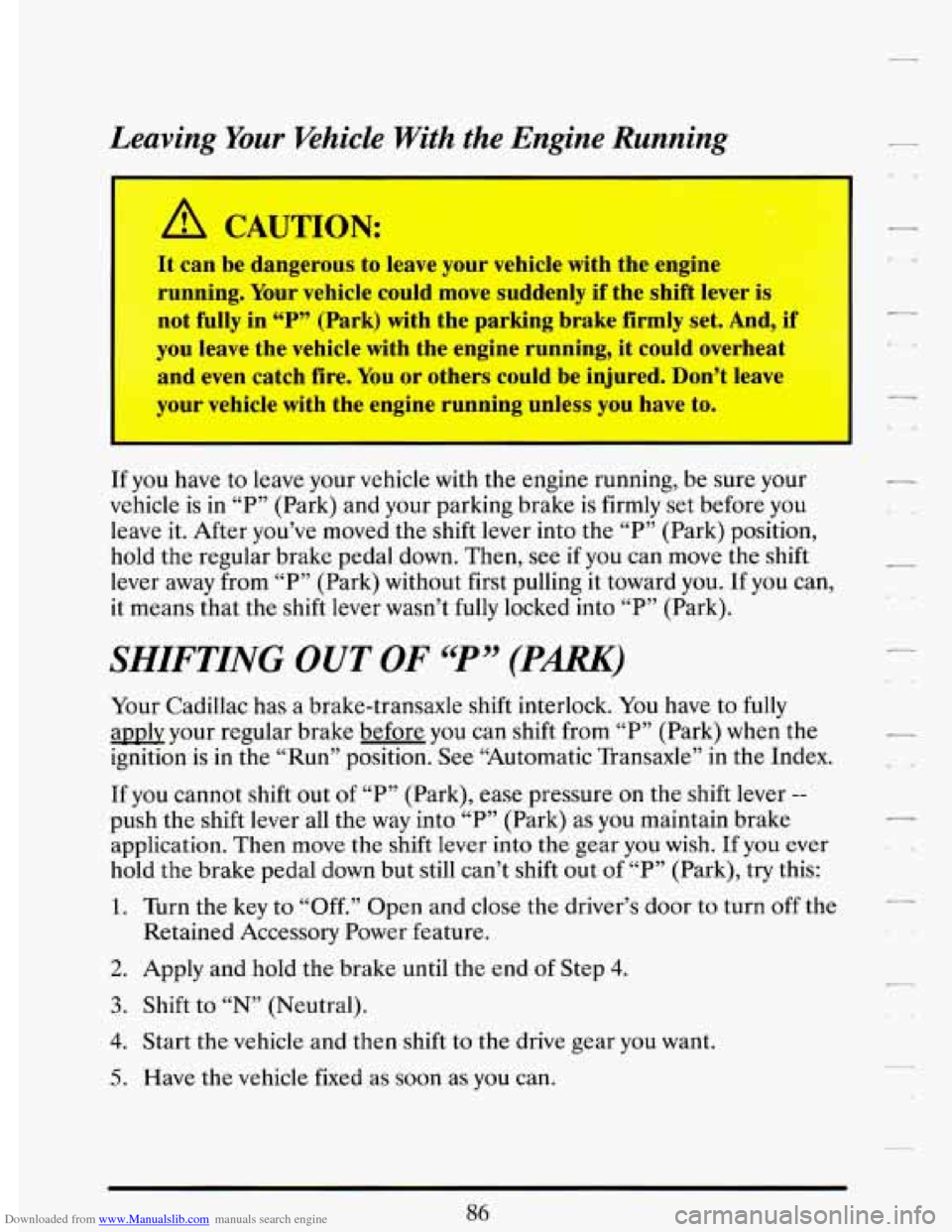
Downloaded from www.Manualslib.com manuals search engine It can be dangerous to leave your vehicle with the engine
running. Your vehicle could move suddenly if the shift lever is
not fully in
“P” (Park) with the parking brake firmly set. And, if
you leave the vehicle with the engine running,
it could overheat
and even catch fire.
You or others could be injured. Don’t leave
your vehicle with the engine running unless you have to.
If you have to leave your vehicle with the engine running, be sure your
vehicle is
in “P” (Park) and your parking brake is firmly set before you
leave it. After you’ve moved the shift
lever into the “P” (Park) position,
hold the regular brake pedal down. Then, see if you can move the shift
lever away from “P” (Park) without first pulling it toward you.
If you can,
it means that the shift lever wasn’t fully locked into “P” (Park).
SHIFTING OUT OF “P” (PARK)
Your Cadillac has a brake-transaxle shift interlock. You have to fully
apply your regular brake before you can shift from “P” (Park) when the
ignition
is in the “Run” position. See “Automatic Transaxle” in the Index.
If you cannot shift out of “P” (Park), ease pressure on the shift lever --
push the shift lever all the way into “P” (Park) as you maintain brake
application. Then move the shift lever into the gear you wish.
If you ever
hold the brake pedal down but still can’t shift out of “P” (Park), try this:
1. Turn the key to “Off.” Open and close the driver’s door to turn off the
2. Apply and hold the brake until the end of Step 4.
3. Shift to “N” (Neutral).
Retained
Accessory Power feature.
4. Start the vehicle and then shift to the drive gear you want.
5. Have the vehicle fixed as soon as you can.
86
Page 102 of 406
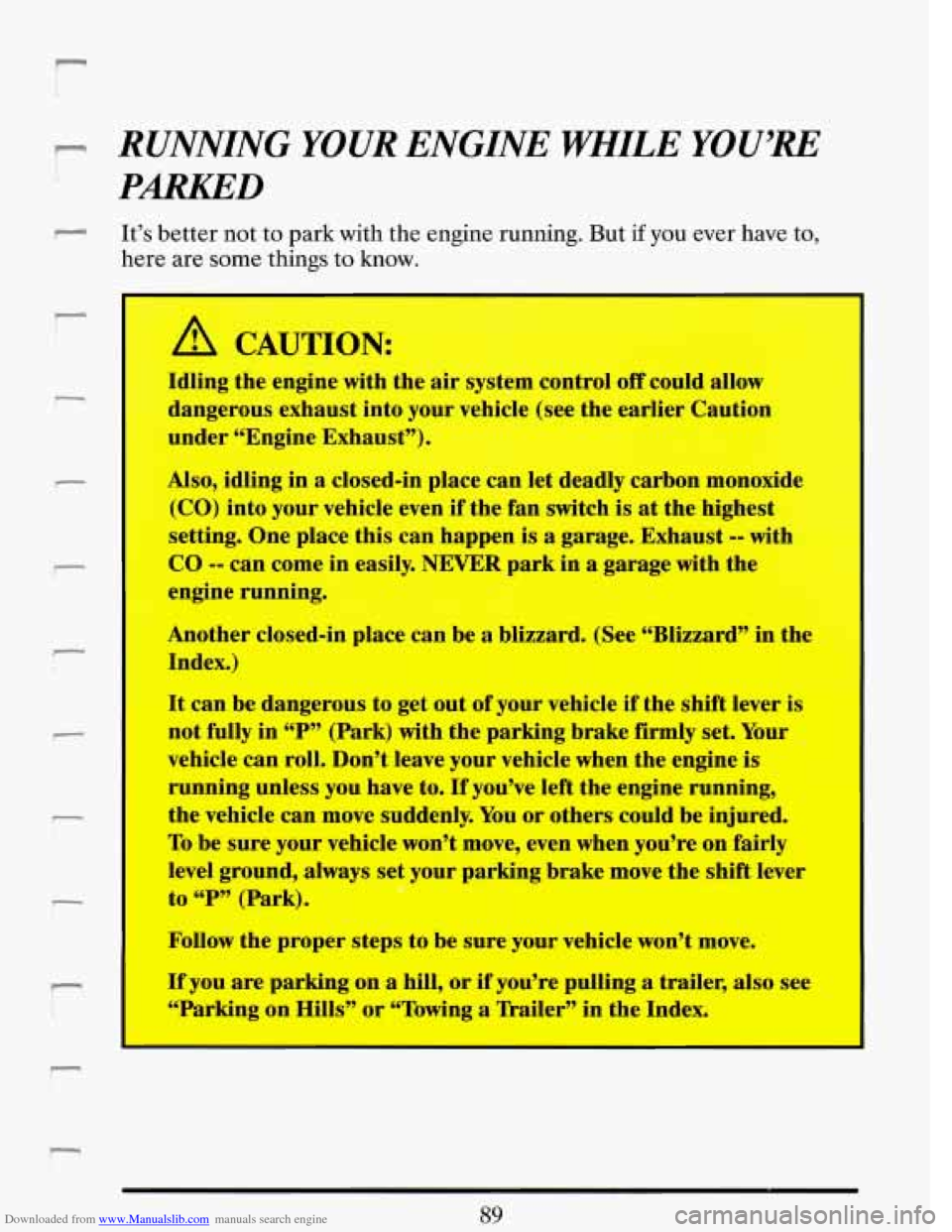
Downloaded from www.Manualslib.com manuals search engine m RUNNING YOUR ENGINE IZIiWLE YOUfRE I
PARKED
r It’s better not to park with the engine running. But if you ever have to,
here are some things to know.
I
F- I
A CAUTION:
Idling the engine with the air system control off could allow
dangerous exhaust into your vehicle (see the earlier Caution
under “Engine Exhaust”).
Also, idling in a closed-in place can let deadly carbon monoxide
(CO) into your vehicle even if the fan switch is
at the highest
setting. One place this can happen
is a garage. Exhaust -- with
CO -- can come in easily. NEVER park in a garage with the
engine running.
Another closed-in place can be a blizzard. (See “Blizzard” in the
Index.)
It can be dangerous to get out of your vehicle if the shift lever is
not fully in
“P” (Park) with the parking brake firmly set. Your
vehicle can roll. Don’t leave your vehicle when the engine is
running unless you have to.
If you’ve left the engine running,
the vehicle can move suddenly. You
or others could be injured.
To be sure your vehicle won’t move, even when you’re on fairly
level ground, always set your parking brake move the shift lever
to
“P” (Park).
Follow the proper steps to be sure your vehicle won’t move.
If you are parking on
a hill, or if you’re pulling a trailer, also see
“Parking on Hills” or “Towing
a lkailer” in the Index.
f
89
Page 134 of 406

Downloaded from www.Manualslib.com manuals search engine When one of the warning lights comes on and stays on when you are
driving, check the section that tells you what to do about it. Pkase
follow
the manual’s advice. Waiting to do repairs can be costly -- and even
dangerous.
So please get to know your warning lights. They’re a big help.
Brake System Warning Light
Your Cadillac’s hydraulic brake system is divided into two parts. If one
part isn’t working, the other part can still work and stop you. For good
braking, though,
you need both parts working well.
If the warning light goes on, there could be a brake problem. Have your
brake system inspected right away.
This light shoula
come
on and turn off as you
start the vehicle. If it
doesn’t come on then,
have it fixed
so it will
be ready to warn you
if
there’s a problem.
This light will also come on when you set your parking brake, and will
- stay on if your parking brake doesn’t release fully. If it stays on after your
parking brake is fully released, it means you have a brake problem. If the
light comes on while driving, pull
off the road and stop carefully. You may
-_ notice that the pedal is harder to push. Or, the pedal may go closer to the
floor. It may take longer to stop.
If the light is still on, have the vehicle
towed for service.
(See “Towing Your Vehicle” in the Index.)
121
Page 189 of 406
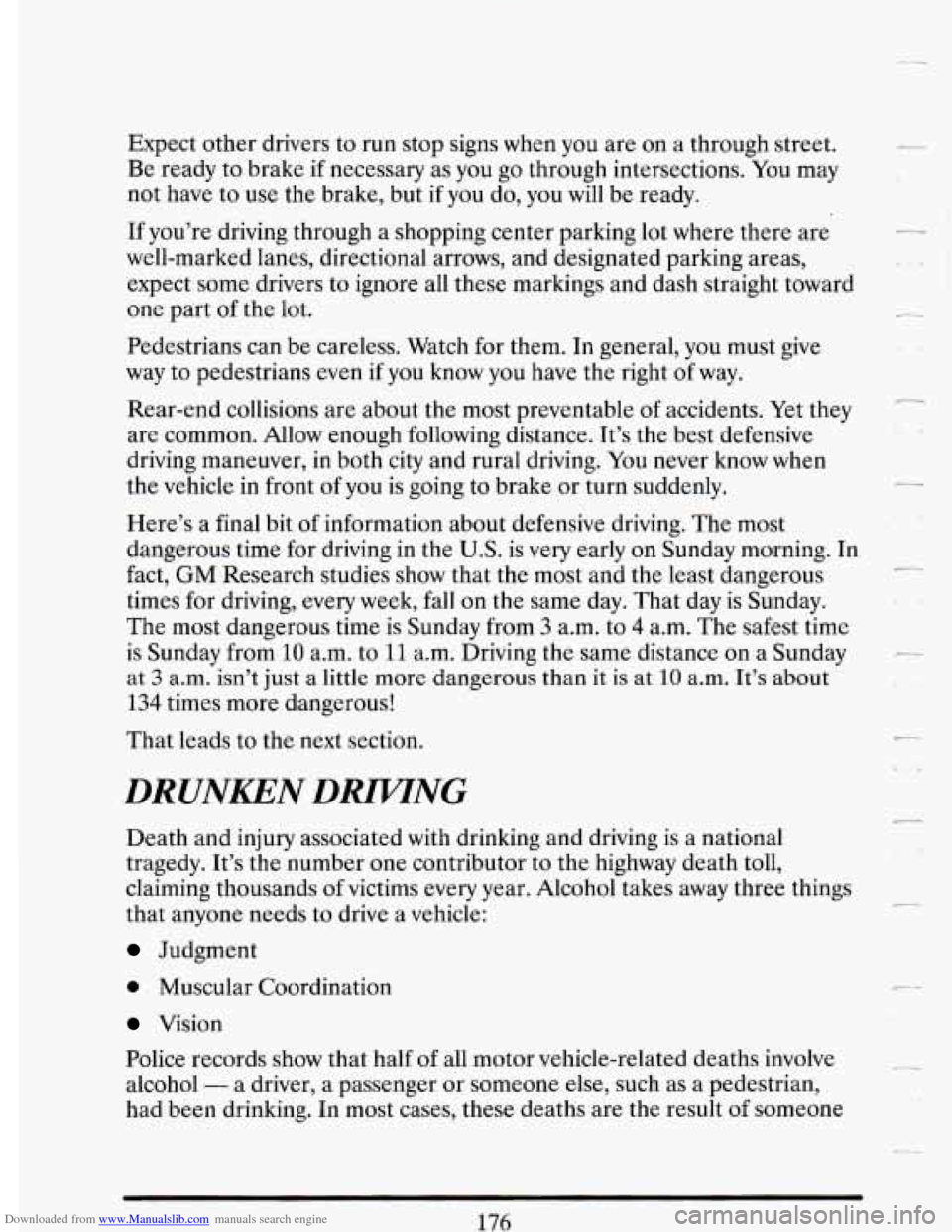
Downloaded from www.Manualslib.com manuals search engine Expect other drivers to run stop signs when you are on a through street.
Be ready to brake if necessary as you go through intersections.
You may
not have to use the brake, but
if you do, you will be ready.
If you’re driving through a shopping center parking lot where there are
well-marked lanes, directional arrows, and designated parking areas,
expect some drivers to ignore all these markings and dash straight toward
one part
of the lot.
Pedestrians can be careless. Watch
for them. In general, you must give
way to pedestrians even if you know you have the right of way.
Rear-end collisions are about the most preventable
of accidents. Yet they
are common. Allow enough following distance. It’s the best defensive
driving maneuver,
in both city and rural driving. You never know when
the vehicle in front
of you is going to brake or turn suddenly.
Here’s
a final bit of information about defensive driving. The most
dangerous time for driving in the
U.S. is very early on Sunday morning. In
fact, GM Research studies show that the most and the least dangerous
times for driving, every week, fall on the same day. That day is Sunday.
The most dangerous time is Sunday from
3 a.m. to 4 a.m. The safest time
is Sunday from
10 a.m. to 11 a.m. Driving the same distance on a Sunday
at
3 a.m. isn’t just a little more dangerous than it is at 10 a.m. It’s about
134 times more dangerous!
That leads to the next section.
-i
r
L.4
DRUNKEN DRMNG
Death and injury associated with drinking and driving is a national
tragedy. It’s the number one contributor to the highway death toll,
claiming thousands
of victims every year. Alcohol takes away three things
that anyone needs to drive a vehicle:
Judgment
0 Muscular Coordination
Vision
Police records show that half
of all motor vehicle-related deaths involve
alcohol
- a driver, a passenger or someone else, such as a pedestrian,
had been drinking. In most cases, these deaths are the result
of someone
176